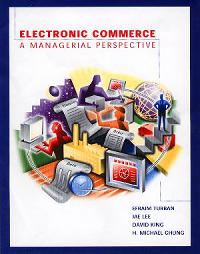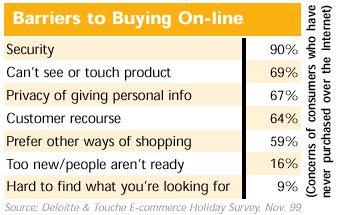| SENECA COLLEGE, TORONTO | |
 |
|
| As Taught by Prof. Tim Richardson School of Marketing and e-Business, Faculty of Business |
| SENECA COLLEGE, TORONTO | |
 |
|
| As Taught by Prof. Tim Richardson School of Marketing and e-Business, Faculty of Business |
DETAILED OUTLINE©
Electronic Commerce and Banking (B2B), (B2C)
| "E-technology
has changed the way we all do business; the way we shop, the way we buy
and sell, the way we close transactions. We seem to be reinventingoutselves
continuously"
"... technology has created fundamental changes in the structure of Canadian banks" What
drives the banks?
|
| Class
5 |
Banking Chapter 7
|
Chapter 7
- Electronic Commerce and Banking
p. 183 Changing Dynamics in the Banking Industry Kalakota's 1997 book is a bit dated but the concepts he discusses still apply to understanding a general overview of the situations facing banks in the e-community. Kalakota notes 5 distinct factors contributing to the new environment - for this class, read, in advance, Chapter 7, and be prepared to discuss the main points
http://ilearn.senecac.on.ca/homepage/Tim.Richardson/iec802/iec802chpt8.ppt |
| . | 
Chpt 5 "Cyberbanking" page 173
|
Turban's book has 5 pages
devoted to the subject of banking, with part of the discussion devoted
to personal banking (B2C) and a little bit discussing corporate banking
(B2B)
Turban concludes this section by quoting a Boston Consulting Group 1998 study on the future of banking. While this study may be interesting, 1998 is 2 years ago - which is a lifetime on the Net. WTGR found an article on
the Boston Consulting Group site titled
"To develop enduring online
businesses, however, banks need to move fast, invest capital, and experiment
with new ventures, realizing that some may fail. Such an approach is an
enormous cultural and organizational challenge for most bankers, who have
built their careers on minimizing risk and avoiding mistakes. But
they have no choice: the opportunities are too great and the threats from
newcomers too palpable"
The authors point out an inherent weakness in the "culture" of the banking industry - that is their propensity to avoid risk - which will cause them to take too long to make decisions in the online world and therefore cause them to, perhaps, lose out on some of the new financial and payment situations being developed.
"Growing Consumer Interest Some bankers question whether
a sufficiently large number of consumers really want to bank online. They
note that in many markets, the growth of the number of online accounts
has lagged expectations. But there is ample evidence that droves of consumers
are poised to embrace online banking. In the United States, more than 15
million consumers checked mortgage rates online in 1999. About the same
number searched online for credit card information. And in the United Kingdom,
more than 5 million consumers logged on to the Internet in 1999 to obtain
financial information. This way of gathering financial information is the
first step toward conducting transactions online. Once consumers start
banking online, momentum can build rapidly. In Australia, there were barely
100,000 online banking customers in early 1999. By the
end of the year, there were 650,000."
Companies are not run by computers, they are run by individuals. Individuals use, or non-use of a product or service will effect how companies use a product. Cyberbanking can't develop in B2B situations until B2C has proven to work out to the satisfaction of those trying personal banking online.
|
| Oct
4 |
|
| Class
5 |
Banks
Profits in Canada |
One of the annual stories
in Canadian business is the growing profits of the Canadian banks. Some
people think it is obscene that in a relatively modest sized economy like
Canada, the banks are the ones at the top of the list in profits - it is
seen to be greedy of them to make such excessive amounts of money at the
expense of struggling businesses. Other people insist that a healthy bank
oligopoly is good for business because it means they have the strength
to allow them to lend to small and medium sized businesses because they
can still count on making money from the transactions they do for large
B2B situations. Which ever way you look at, it is interesting to compare
our situation to the U.S. In the U.S. the leading companies in terms of
profits are manufacturers of consumer products, like General Motors, IBM
etc - American banks are not so prominent on the list of profit takers.
In Canada, all the major banks are right up in the top 10, top 15 in any
given year over the past decade which causes some critics to say it is
not right that these financial institutions should gouge our profits at
a higher rate than their business clients.
WTGR Tom Hirschmann wrote an article
in The Financial Post this summer (02 June 2000) titled
Hirschmann's short article is useful in pointing out that in some cases (Scotiabank and CIBC) part of the massive profits these banks make is either from activities outside Canada, or from other types of activities such as selling real-estate. CIBC for instance made $128 million after-tax gains from the sale of seven real estate properties. |
.
discussed in class #6, October
11th
 |
 www.cba.ca www.cba.ca |
| Industry associations are
one of the best sources of information about an industry as a whole. Often
these associations produce discussion papers and PR material to explain
to government and the public, the opinions and business positions of their
members.
WTGR |
at
www.cba.ca/eng/Consumer_ Kiosk/kiosk_ecomm.htm you will find several links on the CBA web site to pieces of information. Some of these are "backgrounders" which associations use to explain particular issues to the public and government, some of the other pieces are written about e-commercein general for the audiences that might be people wanting to know the CBA's position in the industry. |
www.cba.ca/eng/Tools/Brochures/tools_ecommerce3.htm
 |
This article deals with
the generalities of "buying and selling on the Net", and includes some
bar chart images from the accounting firms. Most of the article is about
how important e-commerce is and how fast it is growong and all the different
things we can do with e-commerce.
WTGR The article is what we call
a "catch all" covering things from the perspective of the business owner,
as well as the customer. They even have a point form list of
|
| /www.cba.ca/eng/Tools/Brochures/tools_ecommerce_appendice2.htm
Glossary |
This section is called by
the CBA
"Glossary of Terms" but as you will find, it is written for a very "junior" audience, meaning people who have only a introductory understanding of the Net. The fact that the list contains such simple terms illustrates that the CBA thinks most of the people using this portion of the web site are almost complete "newbies" to the web WTGR |
| www.cba.ca/eng/Tools/Brochures/tools_ecommerce4.htm | This section is titled
"Consumer and Business Issues" Not surprisingly, the CBA ranks security and privacy concerns at the top. The way this section is written is to convince the reader that although this is a concern, it is being dealt with and you should feel confidence in going online and buying lots of products with your credit card which will help make the banks and their credit card processing agents even richer! (they also quote extensively from the Angus Reid Group) WTGR |
| www.cba.ca/eng/Events/events_ecommerceseminars.htm | One thing associations do
often is hold events for members and non-members. Some of these events
are educational oriented, such as seminars.
There is one event in Toronto, contact is Gwen Bailey, Scarborough Chamber of Commerce ph: 416-439-4140 ext. 223 gbailey@scarboroughchamber.com Since so many of these events are TBA and registration is relatively low, maybe the CBA might be interested in assistance from some e-commerce students! |
October 11th
continued adding in, and
updating
| Our 2000 matrix describing E-commerce and the Canadian banks services to business | Our 2000 matrix describing E-commerce and the Canadian banks services to individuals |
| www.witiger.com/ecommerce/banks~b2b.htm | www.witiger.com/eocommerce/banks~b2c.htm |
| Class
7 |
Oct
18 |
Banking Alliances
|
The Canadian
banks have had many challenges dealing with the new demands of e-business.
Part
of the problem is that these demands require solutions which are not core
strengths of the banks.
The banks have dealt with this inadequacy in two ways 1. creating new departments in their subsidiary companies to address the new e-business needs 2. buy, merge with, ally with other companies who have existing (or newly existing) capabilities which the new e-business is using WTGR In this section we will look at some of the alliances that have developed and also read about some of the acquisitions the banks made to add more capability. |
| Class
7 |
Oct
18 |
Banking Trading
|
It is hard to
talk about banking services in North America in the year 2000, without
mentioning the hype and enthusiasm that individual people have gained for
taking control of their own investments and new found savings to be active
in trading stocks.
www.daytrader.com/links.html All of the Canadian banks
are active in facilitating stock trading to some degree. Although it may
be disputed, TD's subsidiary TD Waterhouse has taken a leadership role
especially with people that have modest amounts of money and want to do
some day trading.
Although the banks are trying
to also carve out a niche to provide information about business, with which
people can use to trade - other companies in the private sector are being
created that focus more directly on stock price information and it is worthwhile
to mention some.
One of canada's busiest internet
sites is
StockHouse has 130 people and has sites and offices in Canada, United States, Australia, China and the U.K. Stockhouse also acts like
a portal by selling advertising to stock market related companies who are
attracted to the many hits this site gets each day.
An annotated list of books on daytrading http://www.daytradingonline.com/recreading/RReading.htm |